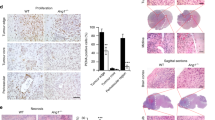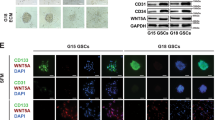Abstract
Angiogenesis is thought to depend on a perfectly coordinated balance between endogenous-positive and negative regulatory factors. Of these factors, the vascular endothelial growth factor (VEGF) and angiopoietins (Angs) seem to play an essential role. Recently, we reported the expression of the Ang-natural receptor, Tie2, in neoplastic astrocytic cells within gliomas. Because of the VEGF/Ang2 functional partnership together with the presence of Tie2 in gliomas, we hypothesized a role of Ang2 on the modulation of VEGF levels in these tumors. We examined the effect of Ang2 on VEGF expression in a panel of glioma cells, which showed that Ang2 inhibited VEGF expression at both mRNA and protein levels in Tie2-expressing cells, but not in Tie2-negative cells. VEGF promoter analysis showed that Ang2 regulated VEGF expression at the transcriptional level in relation to a decrease in HIF-1α expression and HIF-DNA-binding activity. Tie2 silencing by siRNA rescued the Ang2-mediated downmodulation of VEGF, suggesting an essential role for Tie2 in this regulatory loop. To our knowledge, this is the first report on the role of Ang2/Tie2 in the regulation of HIF-1α/VEGF expression, providing additional evidence of the intrinsic coordination that occurs among these factors during angiogenesis.
This is a preview of subscription content, access via your institution
Access options
Subscribe to this journal
Receive 50 print issues and online access
$259.00 per year
only $5.18 per issue
Buy this article
- Purchase on Springer Link
- Instant access to full article PDF
Prices may be subject to local taxes which are calculated during checkout




Similar content being viewed by others
References
Beck H, Acker T, Wiessner C, Allegrini PR, Plate KH . (2000). Expression of angiopoietin-1, angiopoietin-2, and tie receptors after middle cerebral artery occlusion in the rat. Am J Pathol 157: 1473–1483.
Cascone I, Napione L, Maniero F, Serini G, Bussolino F . (2005). Stable interaction between alpha5beta1 integrin and Tie2 tyrosine kinase receptor regulates endothelial cell response to Ang-1. J Cell Biol 170: 993–1004.
Ferrara N, Alitalo K . (1999). Clinical applications of angiogenic growth factors and their inhibitors. Nat Med 5: 1359–1364.
Goede V, Schmidt T, Kimmina S, Kozian D, Augustin HG . (1998). Analysis of blood vessel maturation processes during cyclic ovarian angiogenesis. Lab Invest 78: 1385–1394.
Gomez-Manzano C, Fueyo J, Jiang H, Glass TL, Lee HY, Hu M et al. (2003). Mechanisms underlying PTEN regulation of vascular endothelial growth factor and angiogenesis. Ann Neurol 53: 109–117.
Holash J, Maisonpierre PC, Compton D, Boland P, Alexander CR, Zagzag D et al. (1999). Vessel cooption, regression, and growth in tumors mediated by angiopoietins and VEGF. Science 284: 1994–1998.
Hu B, Jarzynka MJ, Guo P, Imanishi Y, Schlaepfer DD, Cheng SY . (2006). Angiopoietin 2 induces glioma cell invasion by stimulating matrix metalloprotease 2 expression through the αvβ1 integrin and focal adhesion kinase signaling pathway. Cancer Res 66: 775–783.
Kukk E, Wartiovaara U, Gunji Y, Kaukonen J, Buhring HJ, Rappold I et al. (1997). Analysis of Tie receptor tyrosine kinase in haemopoietic progenitor and leukaemia cells. Br J Haematol 98: 195–203.
Lee OH, Fueyo J, Xu J, Yung WK, Lemoine MG, Lang FF et al. (2006a). Sustained angiopoietin-2 expression disrupts vessel formation and inhibits glioma growth. Neoplasia 8: 419–428.
Lee OH, Xu J, Fueyo J, Fuller GN, Aldape KD, Alonso MM et al. (2006b). Expression of the receptor tyrosine kinase Tie2 in neoplastic glial cells is associated with integrin beta1-dependent adhesion to the extracellular matrix. Mol Cancer Res 4: 915–926.
Livak KJ, Schmittgen TD . (2001). Analysis of relative gene expression data using real-time quantitative PCR and the 2(−delta delta C(T)) method. Methods 25: 402–408.
Loureiro RM, D'Amore PA . (2005). Transcriptional regulation of vascular endothelial growth factor in cancer. Cytokine Growth Factor Rev 16: 77–89.
Machein MR, Knedla A, Knoth R, Wagner S, Neuschl E, Plate KH . (2004). Angiopoietin-1 promotes tumor angiogenesis in a rat glioma model. Am J Pathol 165: 1557–1570.
Maisonpierre PC, Suri C, Jones PF, Bartunkova S, Wiegand SJ, Radziejewski C et al. (1997). Angiopoietin-2, a natural antagonist for Tie2 that disrupts in vivo angiogenesis. Science 277: 55–60.
Shirakawa K, Shibuya M, Heike Y, Takashima S, Watanabe I, Konishi F et al. (2002). Tumor-infiltrating endothelial cells and endothelial precursor cells in inflammatory breast cancer. Int J Cancer 99: 344–351.
Suri C, McClain J, Thurston G, McDonald DM, Zhou H, Oldmixon EH et al. (1998). Increased vascularization in mice overexpressing angiopoietin-1. Science 282: 468–471.
Wang J, Wu K, Zhang D, Tang H, Xie H, Hong L et al. (2005). Expressions and clinical significances of angiopoietin-1, -2 and Tie2 in human gastric cancer. Biochem Biophys Res Commun 337: 386–393.
Yancopoulos GD, Davis S, Gale NW, Rudge JS, Wiegand SJ, Holash J . (2000). Vascular-specific growth factors and blood vessel formation. Nature 407: 242–248.
Acknowledgements
We thank Betty L Notzon (Department of Scientific Publications, MD Anderson Cancer Center, Houston, TX, USA) for editorial assistance. This work was supported by grants from NIH (R01-CA83127; CA16672 to Core Facilities at MD Anderson Cancer Center), MD Anderson Cancer Center and Department of Education and Science, Spain (to VA).
Author information
Authors and Affiliations
Corresponding author
Additional information
Supplementary Information accompanies the paper on the Oncogene website (http://www.nature.com/onc).
Supplementary information
Rights and permissions
About this article
Cite this article
Lee, OH., Xu, J., Fueyo, J. et al. Angiopoietin-2 decreases vascular endothelial growth factor expression by modulating HIF-1α levels in gliomas. Oncogene 27, 1310–1314 (2008). https://doi.org/10.1038/sj.onc.1210731
Received:
Revised:
Accepted:
Published:
Issue Date:
DOI: https://doi.org/10.1038/sj.onc.1210731
Keywords
This article is cited by
-
Transcriptome differences in adipose stromal cells derived from pre- and postmenopausal women
Stem Cell Research & Therapy (2020)
-
Tumor Development and Angiogenesis in Adult Brain Tumor: Glioblastoma
Molecular Neurobiology (2020)
-
Dimethylarginine dimethylaminohydrolase 2 promotes tumor angiogenesis in lung adenocarcinoma
Virchows Archiv (2016)
-
Small molecular modulation of macrophage migration inhibitory factor in the hyperoxia-induced mouse model of bronchopulmonary dysplasia
Respiratory Research (2013)
-
Angiopoietin-2: Development of inhibitors for cancer therapy
Current Oncology Reports (2009)



